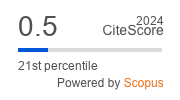Scroll to:
Letter to the Editor Regarding “DRESS syndrome on the background of adding meropenem to carbamazepine therapy: a clinical case”
https://doi.org/10.47093/2218-7332.2023.960.11
To the editor
Drug-induced reaction with eosinophilia and systemic symptoms (DRESS) is a severe condition with diagnostic criteria established by international Registry of Severe Cutaneous Adverse Reactions (RegiSCAR)1 considering a score system based on clinical and laboratory findings [1–5].
We appreciated the report by Ilina Y.V. et al. published in this Journal [3] about the DRESS syndrome that developed in a 29-year-old woman following the postoperative association of meropenem with carbamazepine to the management of focal epileptic seizures and postictal right hemiparesthesia [3].
The manifestations of the DRESS syndrome appeared 8 days after starting the antibiotic, and carbamazepine was suspended, but the diagnosis was only confirmed by the RegiSCAR criteria about a month later. Her treatment schedule with methylprednisolone was then modified by 1 mg/kg body weight, which resulted in clinical and laboratory improvement, and five days later she was discharged to home [3]. Less than a month later, she presented mucosal HSV type 6 and CMV lesions on the nose and lips, that were controlled by administration of valacyclovir and a reduced dosage of methylprednisolone. The authors highlighted the increased diagnostic challenges due to association of administered drugs; the misdiagnosis with diverse similar entities; the longstanding time to appear the first symptoms; and the main role of the prompt interruption of the possible causal agent of the DRESS syndrome [3]. In this setting, the objective of the present letter is to comment on two other recent reviews on the DRESS syndrome, [1][2] besides some Brazilian case studies of this challenging condition [4][5].
Alotaibi M. reviewed the pathogenesis and treatment of this ominous disturbance, that may affect 2.18 per 100,000 people, 55% females, related to antibiotics (74%) or antiepileptics (20%), with almost 95% of hospital admissions, 3% of mortality rate, and high burden on health costs [1]. His comments on recent pathophysiology advances included human leucocyte antigen haplotypes, interleukin-5, thymus- and activation-regulated chemokine, macrophage-derived chemokine, besides and the activation of the Janus kinases-signal transducer and activator of transcription proteins; and cyclosporine was considered a useful tool to get good outcomes of the DRESS syndrome control [1].
Calle A.M. et al. very recently reviewed the main findings associated with the epidemiology, pathophysiology, clinical and laboratory diagnosis, and management of the DRESS syndrome [2]. Phenytoin, carbamazepine, phenobarbital, sulfonamides, dapsone, piroxicam, ibuprofen, diclofenac, beta-lactam antibiotics, vancomycin, allopurinol, minocycline and antiretrovirals are the most common etiologic factors, although in up to 20% of cases, the causative agent is not determined [2]. The diagnosis is frequently late; hepatic failure is a major cause of death; and hyper eosinophilia, thrombocytopenia, pancytopenia, leukocytosis, and coagulopathy are signs of the poor prognosis [2].
Brazilian authors reported two cases of DRESS syndrome. An 18-year-old woman taking phenytoin had fulminant hepatitis and refractory shock [4]; and a 49-year-old man using alopurinol plus diclofenac who had heart involvement but improved with the corticosteroid immunosuppression [5].
Conflict of interests. The authors declare that there is no conflict of interests.
1. RegiSCAR. European Registry of Severe Cutaneous Adverse Reactions (SCAR) to Drugs and Collection of Biological Samples. http://www.regiscar.org/ (Date of access: 02.10.2023).
References
1. Alotaibi M. Drug-induced reaction with eosinophilia and systemic symptoms: a review. Cureus. 2023 Mar 2; 15(3): e35701. https://doi.org/10.7759/cureus.35701. PMID: 37012934
2. Calle A.M., Aguirre N., Ardila J.C., et al. DRESS syndrome: A literature review and treatment algorithm. World Allergy Organ J. 2023 Apr 8; 16(3): 100673. https://doi.org/10.1016/j.waojou.2022.100673. PMID: 37082745
3. Ilina Y.V., Fedorova T.A., Tazina S.Y., et al. DRESS syndrome on the background of adding meropenem to carbamazepine therapy: a clinical case. Sechenov Medical Journal. Epub ahead of print 20.06.2022. https://doi.org/10.47093/2218-7332.2022.407.09. Erratum in: Sechenov Medical Journal. 2022; 13(1): 58–59. https://doi.org/10.47093/2218-7332.2022.13.1.58-59
4. Mikhael B.M., Carvalho M.R.M., Santos V.M., et al. Evolution of DRESS syndrome related to phenytoin in a young woman. Brasília Med. 2022; 59(Annual): 1–5. https://doi.org/10.5935/2236-5117.2022v59a284
5. Santos V.M., Soares A.M.R., Daameche L.N.A., et al. Drug reaction with eosinophilia and systemic symptoms syndrome: a case report. Brasília Med. 2018; 55(Annual): 32–37. https://doi.org/10.5935/2236-5117.2018v55a04
About the Authors
V. M. dos SantosBrazil
Vitorino Modesto dos Santos - MD, PhD, Department of Medicine, Catholic University; Armed Forces Hospital.
Estrada do Contorno do Bosque S/N, Cruzeiro Novo. CEP 70658-900, Brasília-DF
T. A.M. Sugai
Brazil
Brasília-DF







































